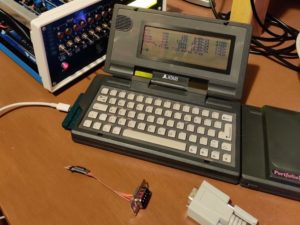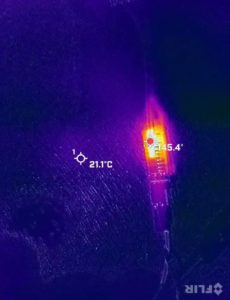If you read the intro post to this years challenge, I set myself a secondary goal of getting many of my old computers talking to my RC2014. So I decided to kick things off with the Atari Portfolio. This was going to be an easy intro in to things as this little DOS compatible palmtop has a serial port expansion and can run DOS based terminal software. So this would be pretty straightforward, right?

The Portfolio serial port is limited to 9600 baud, so this gives me a couple of options on the RC2014. I could either slow main clock right down, which will slow the CPU, but I will get 9600 baud on serial Port A. Or I could slow down Clock 2 and use Port B as the primary port. Rather than dive in headfirst and make a mess of things, I came up with a simple step by step plan;
- Power up the RC2014 and check that it is all working
- Plug in to PC and verify 115200 baud on Port A is working.
- Connect to Port B and verify this works at115200 baud
- Change Clock 2 and check the PC can communicate at 9600 baud on Port B
- Install terminal software on the Portfolio
- Plug the Portfolio in to a serial to USB adapter and check it can communicate with the PC at 9600
- Build a simple MAX232 adapter to convert the RS232 on the Portfolio to TTL serial
- Check this can communicate with PC FTDI
- And, finally, connect the RC2014 and the Portfolio, via the MAX232 adapter, using Port B at 9600
The first 3 steps went without a hitch. Using Port B as the primary port was as simple as flipping a switch when using the Front Panel. However, when I dropped the RC2014 down to divide Clock 2 by 12, I was unable to communicate at 9600 baud. This didn’t bode well. In case I didn’t get the jumper right, I tried setting the terminal to 4800 and 19200, being the speed just above and below 9600, but to no avail. Anyway, long story short, I wasted an hour before discovering that indeed the jumper was of by one, but it gave 14400 baud, which my terminal software didn’t support! So ok, progress, but slow progress.
On to the Portfolio. I plugged in the Serial Port expansion, connected a RS232 to USB adapter, and plugged it in to the PC. Using the DOS command COPY AUX CON meant that whatever I typed on the PC came out on the Portfolio screen, and COPY CON AUX meant that whatever was typed on the Portfolio appeared on the serial terminal.

Now the easy part. I had a few MAX3232 modules which do the RS232 level shifting/inverting. On the Portfolio side I just need Ground, Tx and Rx. On the RC2014 side, Ground, 5v, Tx and Rx. Soldering was about as easy as things get, and it all looked good. Just to be safe, I decided to add an extra step and connect it to my FTDI adapter plugged in to the PC. A second later I dropped it as I felt burn my fingers!

Quickly unplugged everything and checked the soldering, the pin labels, and made sure I was 100% confident that everything looked fine. Plug it in again, touch the chip… Ouch! This was not good.
Time to bust out the FLIR thermal imaging camera. Wow! This thing gets up to 150’C (or 300’F) before I chicken out and pull the power.

Checking online and social media, people had reported problems with the cheap Chinese MAX232 modules. I had my doubts that the chips were genuine. However, some reports stated that the internal pull-up resistors are too weak, so without an input signal it is bouncing around all over the place and causing it to heat up. Others said that a resistor inline with the 5v power might fix it. Those ideas were certainly worth a try.

I can confirm, for my module at least, pull-up resistors made no difference. A resistor in series with the 5v meant that it didn’t get hot… but it didn’t work either. (although quite possibly the vital parts were already burned out?)
It was also pointed out that the chip is actually a MAX3232, which is a 3v3 chip. This would explain a lot! However, the datasheet says that it can work with Vcc from 3v – 5.5v. The TTL input can also be 5v even with a 3v3 Vcc. So, if it is a genuine chip, it _should_ still work
So I had to accept only a partial success, but mostly a failure on this one. The RC2014 worked at 9600 baud on Port B, and the Portfolio could talk at 9600 baud. It was just that they hadn’t talked to each other.
